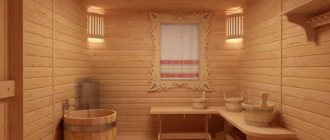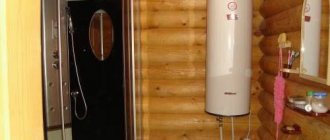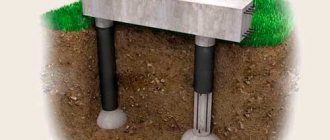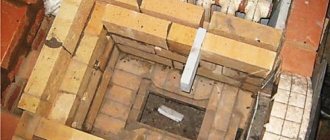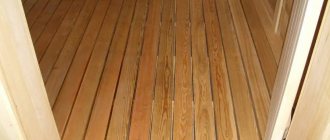Most owners of steam rooms do not think much about how the drain in a bathhouse with a water seal is designed and works. In the process of arranging the sewer route and water drainage, the first option that comes to hand is selected, more or less suitable in size. The locking system somehow serves in the bathhouse until it stops completely and fails. Then it’s time to figure out the problem and make a normal water seal for the bathhouse with your own hands.
When to use a water seal in a bath
In a bathhouse, you need to use a water seal for the sewer if the water drains into the general drainage system. If the water is drained outside the bathhouse into a pit, from where it is absorbed, there cannot be any smell in this case.
If the bathhouse sewerage system is connected to a common system, you can use ready-made siphons (as for a bathtub or washbasin) of any design. Plastic or metal bottle-type closures or corrugated hose closures are available for sale.
Bottle type sewer seal
Sometimes you can still find a cast iron water seal, but their production stopped several years ago, and they are found mainly in old houses.
Water seal for plastic sewerage
CENTER AQUAPA water seals are available for sale, which are inserted into a plastic pipe with a diameter of 55 mm or 110 mm.
The CENTER AQUAPA water seal is inserted into a pipe with a diameter of 110 mm
In essence, the water seal consists of two glasses inserted into one another.
Upper and lower parts of the CENTER AQUAPA water seal
After pouring the floors in the bathhouse, the top of the water seal should be in a small recess to completely drain the water.
The upper part of the water seal is at the level of the lowest point
This water seal has two advantages:
How to make a water seal with your own hands
You can make a water seal with your own hands quite easily. To do this, a piece of pipe of suitable diameter must be bent in the shape of the letter “U” and welded (connected using couplings) to the pipe after the drain funnel (the height of the water seal is usually 50-70 mm). It is advisable to do this while laying the foundation and arranging the floors, but if the bathhouse is already functioning and the smell bothers you, you can try to eliminate this nuisance.
If the foundation is columnar and PVC sewer pipes are accessible, this makes things easier. Under the bathhouse, you can weld the required piece of pipe to the drain pipe. If there is no access to the pipes, you will have to organize it: dismantle part of the floor if it is wooden, or cut it out with a grinder if it is concrete. Then connect a bended pipe to the sewer using couplings or welding.
It is necessary to take into account that water evaporates from any water seal. And if you do not use the sewer for a long time, after 40-50 days it will completely dry out, and gases from the sewer will freely penetrate into the room.
Independent study of the geology of the site
To determine the type of soil, you can conduct an express study that does not require special knowledge and is based on visual inspection and tactile sensations. For this purpose, in the proposed pipe laying location, a hole is dug with a depth of 25-30 cm below the TPG. Information about the depth of soil freezing in a given area can be obtained from neighbors, from reference books, and on specialized Internet resources.
| Regions | Soil freezing depth, cm |
| Vorkuta, Surgut, Nizhnevartovsk, Salekhard | 240 |
| Omsk, Novosibirsk | 220 |
| Tobolsk, Petropavlovsk | 210 |
| Kurgan, Kostanay | 200 |
| Ekaterinburg, Chelyabinsk, Perm | 190 |
| Syktyvkar, Ufa, Aktyubinsk, Orenburg | 180 |
| Kirov, Izhevsk, Kazan, Ulyanovsk | 170 |
| Samara, Uralsk | 160 |
| Vologda, Kostroma, Penza, Saratov | 150 |
| Voronezh, Perm, Moscow, St. Petersburg, Novgorod, Ryazan, Tambov, Tula, Yaroslavl | 140 |
| Volgograd, Kursk, Smolensk | 120 |
| Pskov, Astrakhan | 110 |
| Belgorod, Kursk, Kaliningrad | 100 |
| Rostov | 90 |
| Krasnodar | 80 |
| Nalchik, Stavropol | 60 |
Soil freezing depth
It is important to take a soil sample at the bottom of the pit, since sewer pipes will be laid at this level. After which the soil sample is carefully examined visually, rubbed between the palms, and rolled into a rope.
And they evaluate the results according to the table.
Methods for determining soils
If it turns out that the soil is clay or loam, you should know that these categories of soil are classified as highly heaving. In this case, the pipes will need to be laid on a sand “cushion” by analogy with “floating” foundations. The sand will act as a shock absorber during seasonal soil movements and the integrity of the underground part of the sewer system will not be compromised.
After the safe depth for laying the pipeline has been determined, the issue of the location of the septic tank (filtration well) is resolved. The wastewater collection point must be separated from the water intake point by at least 15 m and located no closer than 7 m from the foundation of the bathhouse.
What is a dry water seal
There is another option for a water seal - dry. There is no water in it, and various materials are used as a damper. As you understand, such a water seal does not freeze. There are several types of dry water seals for sewerage:
This is what a drain with a dry water seal looks like
For a bathhouse, you can make a basic dry water seal with your own hands, it’s quite simple. You need to choose a plastic ball slightly larger than the drain pipe. Put it on the pipe and make some kind of chamber within which it will be located. When there is no water, the ball blocks the access of air from the sewer. When water enters, it floats up (within the chamber) and releases the drain. Such a system is also functional in winter conditions : even if the ball freezes to the drain, a little hot water will melt the ice in a matter of minutes, and the system will function normally.
Source
What is a water seal and its types
What is such a device? A water seal is a specially assembled water plug that protects the room from the characteristic sewer smell. Liquid accumulates in the curved section of the pipe, completely covering the diameter. Thanks to this, the water will prevent unpleasant odors from entering the bathhouse.
Water seals are divided into the following categories:
Design of knee water seals
In its design, a water seal of this type resembles a hookah, but does not allow air to pass through, but creates a water plug, and in a hookah the water seal breaks.
The diameter of the pipes and the method of their connection directly affect the performance of this device; the most important requirement for it is tightness . In this case, the lower point of the water seal must be at least 50 mm below the drain pipe.
You can use anything you like for the water seal, but remember that if access to it is closed, then everything will depend on reliability and the ability to clean it.
After the water evaporates from the plug after about 50 days, it becomes possible for air to enter from the sewer. Therefore, the water seal should be filled with water from time to time or another design should be chosen so that it can be hermetically sealed during long periods of absence.
Bottle water seal and its characteristics
The design of this device is different, but its task is the same as in the previous case - creating a water plug. In another way, a water seal is also called a siphon . A water seal of this type also acts as a sump; the pipe connection in it must be airtight.
You can unscrew the lower part of the bottle washing device for cleaning, and if you use a water seal of this type, made with your own hands, in particular, in the floor, then its upper part should have a collapsible design.
volkovysk rent a room for a long time
Tips for use
If you have done everything correctly, ensured the slope and evenness of the pipe run, if the pipe is laid below the freezing point of the soil and has a sufficient diameter, and the hole is deep and has enough drainage, then operation will be problem-free. But if they arise, then there are ways to solve them.
Dirt in the drain
Hair, some dirt, and residues from bath procedures may go down the drain. Everything is easy and simple here: the pre-designed floor boards are removed, the ladder is removed and cleaned. If the blockage is in the pipe, then it is not long at all, and the blockage can be removed with an ordinary brush on a pipe cleaning wire. It is not advisable to use chemical cleaning agents - nevertheless, this water will somehow end up on your site.
The pipe freezes in winter
When the drain pipe lies with too little slope or wave, water remains in any bend and freezes. This prevents free flow, and the pipe freezes along its entire length. In addition, water may stop flowing and freeze even with a normal blockage. Ice in pipes has a larger volume than water and can rupture them. Therefore, if the pipes are frozen, you need to defrost them urgently.
- With the drain removed, boiling water is poured into the pipe with an Esmarch mug (in common parlance - an enema).
The enema defrosting method is the simplest, and the tool is always at hand
- A steam generator is a luxurious tool: we insert the hose of the device into the pipe, and high-pressure steam very quickly defrosts all the ice plugs.
A steam generator is the fastest way to defrost pipes
- As soon as the pipe has thawed, you need to dig it out as quickly as possible and insulate it with insulation products.
DIY water seal
There are many ready-made designs on sale, but many are interested in how to make a water seal yourself.
The work is carried out in this way: All actions are best performed at the stage of laying the foundation and arranging the floor covering. But if your bathhouse is already ready, but the unpleasant smell in it is bothering you, then you can build a water seal with your own hands later.
The work will be quite easy if there is easy access to sewer pipes and the foundation of the building has a columnar structure. You can weld the required section of pipe to the drain pipe under the bathhouse. And if there is no access to the pipes, then it is provided in this way:
Please note that if the sewer is left idle for a long time, the water may evaporate. After about 50 days, it will dry out completely, and unpleasant odors will enter the room. As mentioned earlier, in such a case it is better to choose a water seal of a different design.
What is a dry water seal and its types
Water seals can also be dry. You can buy it ready-made or make it yourself. They do not freeze and are divided into two types:
Float seal
The design of this water seal is as follows:
In the operating position of the device, water is able to lift and hold the float at the required level, which actively supports the operation of the system . If you do not use the bathhouse for a long time, the water from the water seal will evaporate, but the float will close the drain hole before the water has completely evaporated.
If we talk about a design that you can make with your own hands, then it can work no worse than the factory one if the float in it in the form of an inverted glass is attached in such a way that the bottom is located above the drain hole. And it itself closes with a light ball, which has a slightly larger diameter. This ball will act as a float.
Characteristics of a pendulum hydraulic seal
Below, next to the shutter, there are two curtains that are suspended from the vertical at an angle, which serve as a pendulum shutter. They close due to their weight, and open through the force of water when draining. The height of the water column of such a valve is 32 mm, which is quite enough for a village or country bathhouse. Sometimes it reaches 60 mm .
Some craftsmen change the force of gravity to springs, and then different versions of dry spring-type valves with greater functionality are created.
There are other types of dry water seals, they have specific names like the cellular memory of its material. As a rule, these are stockings based on flattened rubber, which begin to let water through under slight pressure, but they are not particularly suitable for country baths.
Any type of water seal, even with limited possibilities, can be improved or made with your own hands. Assembling a dry water seal yourself is not that difficult. To do this, take a plastic ball that is slightly larger in size than the drain pipe itself . When there is no water, the ball will block air access from the sewer. The drain will be released after liquid enters. Such a system can work at any time of the year, even if in winter the ball freezes to the drain. The ice will melt very quickly with boiling water and everything will return to normal.
Manufacturing Features
You can make a grate for the floor of a bathhouse with your own hands. The work will be carried out in several stages:
- Preparatory. A design diagram is drawn, i.e. The required size and number of required flooring boards are determined. The standard platform has dimensions of 60x60 cm. Based on these conditions, the number of boards required is 4 pieces, the gap is 2.5 mm, and the boards should be 12.5 cm wide. 4 boards are cut 60 cm long. The base is made of 50x50 timber mm. For it, 2 bars 58 cm long are cut. All elements are carefully processed with a plane and emery cloth.
- Assembly of the structure. The base bars are laid parallel to each other so that the distance between their outer edges is 58 cm. The flooring boards are attached to the bars, and they should protrude from their edge and end by 1 cm, fixed perpendicular to the bars and strictly parallel to each other with a gap of 2.5 cm. Fastening is done with screws, their heads must be recessed into the wood. To do this, it is advisable to pre-drill a hole at the mounting location.
- Final activities. To increase the reliability and practicality of the grille, the following work is carried out: all wooden parts are impregnated with an antiseptic composition using a paint brush, which will protect the wood from rotting. In practice, oil is often used for this purpose. To prevent the platform from sliding on a slippery bath floor, it is recommended to secure rubber feet (gaskets) at the bottom.
On a note! When assembling a bath grate with your own hands, you should take care of the tools in advance.
You need to prepare an electric drill, a plane, a screwdriver, a hacksaw, a paint brush, a metal ruler, a tape measure, clamps or a vice, a file, and sandpaper.
Sewerage and floor installation
It is worth saying that laying a sewer line will be much more difficult than arranging a drain from a bathhouse, but this should be done as carefully as possible.
Even if the bath floor is covered with wooden gratings, it is still better to make a screed along the beacons with a uniform slight slope towards the ladder; you will need to lay tiles along it. The last trimming of the drain extension is done when you know for sure the height of the tiles in relation to the drain point. If everything is done as carefully as possible, then even with a small slope there will be no puddles.
For an ordinary bathhouse, providing access and the ability to replace all elements without exception is an almost unrealistic phenomenon. Do not avoid those works that, at first glance, may seem insignificant, for example, the depth of laying a sewer system should at least correspond to the freezing depth.
If the ladder is dry, then if dirt gets into the seal, it will prevent the water seal from closing tightly. At the end of the season, it is recommended to wash the removable elements.
You need to choose a water seal depending on your needs . Whether you buy it ready-made or do it yourself is your own business. If the design is made well, it will not be worse than the factory model.
Source
Do-it-yourself water seal for a bath
Most owners of steam rooms do not think much about how the drain in a bathhouse with a water seal is designed and works. In the process of arranging the sewer route and water drainage, the first option that comes to hand is selected, more or less suitable in size. The locking system somehow serves in the bathhouse until it stops completely and fails. Then it’s time to figure out the problem and make a normal water seal for the bathhouse with your own hands.
Classification
Water drains from the bathhouse are classified depending on the design and the presence of automatic mechanisms. Each of them has features.
Non-pressure
Non-pressure devices are simple structures that are installed in small baths. Suitable for steam rooms in which water procedures are performed simultaneously by no more than 2 people. The liquid flows down the drain as the floor is covered. The more it is, the faster the liquid will drain.
Pressure
Complex design for water drainage. The system is equipped with an electronic liquid suction mechanism. The water dressing room can bathe many people at the same time. Water will not be able to overflow the thresholds of the room.
Mortise
A semicircular drain, which is made of thick plastic, metal, concrete. The drain is located above the surface of the earth. You need to make a recess under the place for liquid drainage. Otherwise, the water will spread throughout the summer cottage.
Water seal for sauna sewer
There can be a lot of problems with the water drainage system. Most often it is necessary to redo or modify the existing drain for two reasons:
Sometimes attempts to speed up the flow of water using brushes or cable brushes lead to depressurization of the drain and even breakage of the bellows seal. Even if the water has gone, you still need to inspect the drain, otherwise the plug will occur with enviable frequency.
The main purpose of the water seal
The system for locking the outlet into the sewer is used primarily to reliably cut off the internal space of the outlet pipes from the bathhouse atmosphere. Otherwise, odors and gases released from the drains will easily break through into the washing and steam room of the bathhouse.
The second purpose of the drain valve is to block wastewater discharged into the sewer. A bellows or any other type of valve locks dirty water and prevents it from rising into the bathhouse through the drain hole in the floor.
Varieties of plums
There are three ways to organize water flow:
- dumping into the ground is quite convenient if the building is placed next to a body of water (as is often done). However, when using detergents in a bathhouse, this option is unacceptable; wastewater with chemicals cannot be discharged into the ground directly, without treatment;
- installation of a septic tank on the site. For a bathhouse built next to a residential building, the drainage from which is carried out into a septic tank, this is the best option. The main problem is that it is necessary to take into account the additional volume of sewage water immediately when purchasing and installing a septic tank, otherwise it will fill much faster than planned at the design stage;
- connection to the centralized sewer system. The most complex option in terms of labor and money, but it practically does not limit users in terms of the composition of waste water and its volume.
The choice of device type depends on several important factors.
- the nature of the building and its location. For a bathhouse built within the city, next to city centralized communications, it is only possible to discharge into a centralized sewer or septic tank. In conditions of dense development, the discharge of water into the ground is unacceptable, since it can lead to soil destruction not only in one’s own area, but also in neighboring areas, and an unpredictable rise of upper groundwater;
- foundation structures. For strip and slab foundations, an existing basement or underground, wastewater must be collected in a single reservoir and drained from there through a pipe. Discharge of liquid directly through the floor into a pit or directly into the ground is only possible when constructing a bathhouse on a columnar or pile-screw foundation;
- type of soil. For clay soils, heavy loams and other soils with a high ability to absorb moisture, the discharge of water onto the soil surface will lead to erosion of the foundation, destruction of supports, flooding of basements and deterioration of the soil condition in the area as a whole.
Conclusion: direct discharge of wastewater from a bathhouse into the ground is possible in a pile structure located on the shore of a reservoir, provided that chemical detergents are avoided and the soil is dense and not prone to erosion. In other cases, it is necessary to organize discharge using a pipeline into a sewer or septic tank.
Water seal for a bath: types
Unlike conventional bathrooms and showers, baths use drains with increased capacity. That is, the size of the drain receiving grid is usually 100x100 m or even more, instead of the standard 60x60 mm. In this way, it is possible to ensure normal operation of the drain even with a large amount of soap and dirt residues.
In addition, you have to take into account the size of the bathhouse, the design of its floors and the frequency of use. Therefore, several water seal schemes are used for the drainage device:
The first and third types of water seals are classified as “wet” types of devices; for their normal operation, the presence of a sufficient amount of water in the system is extremely important. The second and fourth are classified as “dry” devices; they work equally well in baths, both under normal conditions and when there is a lack of water in the drain chamber.
The roof collapsed in a water park in Moscow
Step-by-step installation instructions
It is easiest to install a drain for a shower stall under the tiles during construction, since its installation is indicated in the project. In the finished room, you will have to completely remove the flooring for high-quality installation. It is desirable that the sewer pipe is completely visible on the exposed base. Most often, houses have cast iron pipes, the service life of which has long expired, so it is recommended to completely or partially replace them with plastic ones.
Diagram of the installed ladder Source www.aco.hu
Required installation tools
Installing a shower drain in the floor under the tiles involves the construction of a moisture-proof floor covering. Buckets and a mixer will be needed to mix the solution. To apply it evenly to the surface, spatulas and trowels are used. When removing the floor covering, a hammer drill is used.
Full list of recommended tools:
- ruler with a long tape measure;
- tile cutters for tile covering;
- all kinds of screwdrivers and wrenches;
- wire cutters
The most important thing is that the drain is fully equipped, along with pipes and ceramics.
Wet valves
If you choose a water seal for a bathhouse based on the efficiency of locking, then the best option would be a hydraulic circuit with a curved U-elbow, or an annular chamber with a concentric partition.
Eternal knee
A water seal in the form of an elbow requires a free space of at least 150 mm in height for pipes with a diameter of 50 mm and an overhang of 250-300 mm for a full drain with a cross-section of 100 mm. Therefore, knee bellows are used primarily for bathhouse projects on stilts or columnar foundations. To reliably lock the pipe, the height of the water column must be at least one and a half diameters of the channel.
The main advantage of a water seal is its simplicity of design; it is quite possible to make such a siphon for a bathhouse with your own hands from parts of sewer fittings and pipes. It turns out not as beautiful as industrially made drains, but for a bathhouse it is more important that the structure is easy to repair and simple to maintain. The knee can be easily cleaned, either with a brush or with specialized attachments, rotating brushes and even chemicals such as “Mole”.
This type of drain can work in a properly constructed bathhouse for a couple of decades, until someone uses a cable to punch a hole in the plastic elbow of the water seal.
Flat water seal
For a bathhouse installed on a strip foundation, it is best to use a trap water seal. Its height usually does not exceed 10-12 cm, so the drain box can be safely mounted into the floor screed, and no additional fastenings are required for connection to the sewer.
For example, the “CENTER AQUAPA” model consists of two halves. In the bottom part of the water seal there is an annular cavity with water, which, after installing the top cover, will be divided by a partition. The result is the same bellows, but with a gate height of only 15-20 mm. The drain body is simply put on the receiving hole of the compensating adapter of the sewer pipe of 110 mm.
The box-shaped design turned out to be quite reliable and easy to maintain; the only drawbacks include a small level of water in the water seal. In summer, the water in the drain evaporates, and, accordingly, odors from the septic tank will break into the bathhouse within a couple of days. Whereas in the bellows elbow the water seal will last 3-4 days.
In winter, in a country bathhouse, the drain drain may freeze, but this does not affect its operation in any way. There is little water left, so the risk of damage is minimal. A water seal with an elbow can actually be crushed by frozen water.
Float device for organizing a drain in a bathhouse
Structurally, the water seal with a float is very similar to the previous version of the water seal. The only difference is that in the ladder version, the outlet hole is blocked by raising the water level, and in the float version, the same window is blocked with a foam liner.
Float valves very tightly and reliably block the drain passage even with a minimum amount of liquid. In practice, the drain in the bathhouse can be reliably blocked within 10-15 days from the date of the last visit to the steam room. Among the disadvantages, one can note the sensitivity of the water seal to contamination. After soapy water, the float must be washed with clean boiling water.
Video description
Installation of a drainage well:
Ground filtration
This is an optimal drainage system that can be used as a general sewer system for the entire site. Wastewater is transported through inclined pipes into a septic tank, where it is purified and distributed through several pipelines. They take it to the garden to organize irrigation, or accumulate it in a prepared tank. In some designs, the filtered liquid is simply poured into the ground and absorbed.
Advantages of the soil system:
Flaws:
How to install the system step by step:
The gravel layer will need to be changed periodically (every 10-12 years)
Design is carried out not only from the side of the site, but also inside the bathhouse.
Dry water seal for a bath
Until recently, for most summer residents there was a problem of how to dry the drain in winter, and thereby preserve the pipes and shutter of the bathhouse during the period of frost. Most often, water was simply drained from the water seal elbow through an additional fitting. The solution to the problem was to use a dry shutter for the bath.
Pendulum or leaf shutter mechanism
The design of a dry water seal differs from the ladder or float version only in the presence of two plastic curtains suspended above the outlet window on a pendulum suspension.
The petals do not create obstacles to the flow of water moving from the bathhouse through the window into the sewer pipe. In the opposite direction, the mass of water presses the curtain against the window and blocks it. As a result, the internal cavity remains dry and impermeable to gases from the sewer system.
Controlled type of water seal
Used in bathhouses not connected to a centralized sewerage system. The design of the water seal is almost identical to the drain drain design. The only significant addition is the presence of a controlled valve. At the top of the grille there is a ring, by clicking on which you can snap a ring petal that covers the window into the drain pipe.
In this case, the water is drained directly into a container for collecting dirty water. After completing the procedures, the water seal opens or closes, depending on whether the bathhouse needs to be dried or not.
In this case, the waste collection container can be equipped with an improvised valve according to the diagram below.
It was on this principle that drainage pipes were installed in the Sandunovo steam rooms and baths in the last century.
For example, if a bathhouse is used all year round, then in winter a wet-type water seal can cause failure of the drain and the receiving flank of the sewer pipe. Dry transoms for a bathhouse turn out to be too capricious. The controlled drain option requires no worries at all. Even in winter, after a bath, there is no need to blow out and dry the drainage part. It is enough to open the valve and leave it to dry until your next visit to the bathhouse.
How to make a water seal for sewerage in a bathhouse
The transom “wet” version of the shutter is considered the easiest to install. First, before the floor equipment, it is necessary to lay a 100 mm sewer pipe with a swivel angle. The upper edge of the corner should be located 20 mm below the level of the concrete screed.
The inlet hole is closed with a plastic plug, in the center of which a weaving nail is installed. After pouring the screed, the nail will help to correctly mark the contours of the future hole for water drainage equipment on the bathhouse floor.
After the base screed of the bathhouse floor has completely hardened, it is necessary to level the hole and give the edges even, rounded shapes. This can be done using a grinder and a stone disc with a diameter of 125 mm. You have to cut not in the radial direction, but in the axial direction, that is, with the entire edge of the disk at the same time.
Next, all that remains is to install the water seal body, cap and external drain grate.
The simplest version of a bolt with an elbow can be made from four plastic corners connected to each other in a U-shaped structure. The only thing that needs to be done is to glue the sealing collars with sanitary sealant, otherwise the structure will very quickly split into two parts.
Reasons for water seal failure
Often in bathhouses connected to a central sewer, an unpleasant phenomenon occurs such as squeezing out the water seal. The liquid from the water seal can either be squeezed out into the steam room or washing room, or discharged into the sewer pipe.
water was seeping down the walls here and there
In both cases, the reason for the release of the water seal is the lack of ventilation of the sewer lines. Excessive pressure inside the pipes squeezes out the contents, and if a large amount of water is discharged into the sewer near the drain point, the water seal, especially the transom seal, can easily be left without liquid in the bellows.
Options for drain drain systems
As a rule, experts recommend three types of drains for use in bathhouse conditions:
- Classic ring drain path;
- Linear drain with grating;
- Dry or float drain with mechanical bellows blocking.
The principle of operation of all devices is approximately the same; differences may be in the method of blocking the flow area and the design of the ladder itself. This is convenient; you can always choose one or even two different devices that are best suited for the specific configuration of the steam room or washing compartment of the bathhouse.
What is a water seal
They come in two types:
U-shaped (knee) water seal
From the figure it is absolutely clear that this simple device, similar to a hookah, unlike it, does not allow air to pass through, creating a water plug .
And what happens in a hookah is called a breakdown of the water seal. The diameter of the pipe and the method of connection can only affect the performance of such a device; the main thing that is required of it is tightness , and its lowest point must be at least 50 mm below the drain pipe.
Any materials at hand will be suitable for the water seal, but we must not forget that in the case where access to it is closed, reliability and the ability to clean it are of decisive importance.
The second picture shows how water, having evaporated from the plug (and this will definitely happen in 40-50 days), opens up the possibility for air to penetrate from the sewer.
So you need to either periodically fill it with water, or use a different type of water seal, or seal it hermetically during a long absence.
Bottle water seal
It is also clear that the pipe connection must be airtight. Such a water seal is also a settling tank.
The lower part of a regular bottle siphon for washing can be unscrewed for cleaning, and if a homemade valve of this type is used, for example, in the floor, then the upper part should be collapsible.
Prices ↑
The cost of valves is affected by:
- material of manufacture;
- design features;
- connection method.
| Locking device/material of manufacture | price, rub. |
| Curtain/PVC, Ø 50 | 550 |
| Curtain/PVC, Ø 110 | 1200 |
| Curtain/PVC, Ø 200 | 4800 |
| Ball/cast iron, Ø 100 | 5700 |
| Ball/cast iron, Ø 200 | 24000 |
| Wafer/steel 110 | 1350 |
| Check valve/125 steel | 11500 |
| Air/plastic | 350 |
Dry water seals
The most pressing issue for a bathhouse with a drain into the sewer is not so much the choice of drain design as the laying of the line itself. Any ready-made version of the drain from the store, including the “dry” one, contains a water seal with a water column of 30 mm or more, so that with regular use of the bathhouse, no problems with drying out the water plug will arise . And anyone who knows that the bathhouse will not be in use for a long time can simply plug the drain.
For those who want to forget and not remember about the dried siphon, there are so-called dry drains.
There are two types of dry water seal.
Float type
It is best to consider a specific sample, for example, the Austrian HL 310 NPr.
Vertical drain. The top element is cut to the required size from 12 to 70 mm and embedded in the screed.
The polyethylene body is designed for waste water temperatures up to 85 degrees. The installation procedure for different cases is described in the passport.
The float, when the water dries out, simply lowers and closes the pipe. The height of the water column of the valve is 50 mm (corresponds to Austrian city regulations).
The principle of operation is clearly visible in the picture.
In the working position, the water raises and holds the float at the same level and the system works as one of the water seal options. If the bath is not used for a long time, then the water from the valve evaporates , and the float closes the drain hole before the water has completely evaporated.
Craftsmen have come up with an option that can work no worse than the factory one. The main difference from this scheme is that such a float in the form of an inverted glass is fixed so that its bottom is higher than the drain hole than the diameter of the drain pipe. And the hole itself is covered by a light ball with a diameter larger than the drain one - it acts as a float.
Pendulum type
Below, near the shutter, two curtains are visible, suspended at an angle to the vertical - this is the pendulum shutter. The curtains are closed due to their own weight, and the water opens them when drained. The height of the water column of the water seal is 32 mm - quite enough for a country bath. In Germany itself, which is declared as the manufacturing country, when designing a sewerage system in city houses, it is assumed that plumbing fixtures in apartments have a water column height of the water seal equal to 50-60 mm, but not 32!
If the force of gravity that closes the curtains is replaced by the force of a spring, then you will get different versions of spring-type dry shutters with wider capabilities.
Of course, all of the valves listed contain some version of a siphon.
There is another type of dry closures, for which sometimes too abstruse names are invented, such as cellular memory of the material. Usually they are a stocking made of flattened rubber , which begins to let water through under low pressure. This is unlikely to be of interest for a country bathhouse.
Skillful owners, even with very limited funds, can easily reproduce and, possibly, improve any type of water seal.
Floor and drainage
Laying a sewer line is much more hassle than directly draining a bathhouse, but it is better to do it, the more carefully, the better.
Even if the floor in the bathhouse is covered with wooden gratings, it is still better to make a screed along the beacons with a slight uniform slope towards the ladder , and lay tiles on it. The final cutting of the drain extension can be done when it is known exactly at what height the tiles will approach the drain point. If the work is done very carefully, then even with a minimal slope there will be no puddles.
Providing access, with the ability to replace all elements, is too much of a luxury for an ordinary bathhouse. Therefore, you should not avoid work that may seem unnecessary, for example, the depth of laying the sewer system should not be less than the freezing depth . Insulating the floor under the screed with a 20 cm layer of expanded clay with a rich cement mortar is by no means an excess. A dry ladder is also not a panacea - dirt that gets into the shutter can prevent it from closing tightly. At the end of the season, it doesn’t hurt to wash the removable elements. Buying a dry water seal in a store or making it yourself - this question is not necessarily related to financial difficulties.
Source

